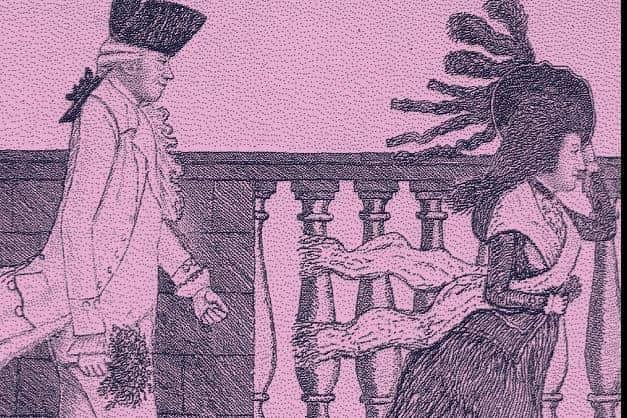Edinburgh's Dr Sex and his services to women should be remembered - Susan Morrison
Having, or not having, babies has been a controlling feature in women’s lives for centuries. Aristocratic women came under immense pressure to create that heir and spare almost as soon as they walked back up the aisle.
For those who failed to fill the nursery, the world could be a cruel place. Wives could be shuffled off to convents and later lunatic asylums. Henry VIII sent his wife to the executioner's block when the promised son didn’t appear.
Advertisement
Hide AdAdvertisement
Hide AdNot surprisingly, these women could be desperate. They were always blamed.The fact that the problem might have been on the other side of the bed was rarely mentioned.


By the late 18th century, wealthy Edinburgh women in need of an heir could call upon the services of Dr James Graham, a man with an interest in fertility, and incredibly for the age, not afraid to show it. Long derided as a quack, some of Dr Graham’s advice has now been re-evaluated as being pretty sensible and possibly even beneficial. His attitude to the women who came to him was certainly ahead of its time.
James was born in June 1745 in Edinburgh’s Cowgate. His father was a saddler, not a bad trade. Money was definitely spent on the boy’s education. He attended the University of Edinburgh, but left without taking his degree. That wasn’t uncommon. The degree exams cost money, and why bother if you can stick ‘Doctor’ in front of your name and start charging for consultations?
He was by all accounts handsome and charismatic, and Edinburgh’s ladies of wealth certainly seemed to enjoy his bedside manner. Dr Graham and his soothing ways attracted a very wealthy clientele. Eventually he outgrew Scotland. Like many an ambitious Scottish medic, James hit the high road South and when he reached London in 1775, he built his masterpieces to mating,‘The Temple of Health’ and in 1780 “The Temple of Hymen”.
The temples boasted golden walls, gilt edged mirrors, velvet hangings and luxurious greenery. Every inch of this glorious doctor's surgery was detailed in his self-penned publicity pamphlet called ‘A Sketch: Or, a Short Description of Doctor Graham’s Medical Apparatus”. It was 92 pages long.
In the very heart of the Temple of Hymen was The Celestial Bed, guaranteed to aid conception. It was twelve feet long and nine wide. It could ‘tilt to the pull of the tide’. Sweet airs and scents wafted across and soothing music could be heard. Nymphs frolicked enticingly and turtle doves fluttered above the silken sheets. Drinks and snacks were provided.
And most scientific of all, the very power of life could be harnessed to improve fertility. Electricity.
Now, before we book in for the evening, it is worth taking a closer look at the therapist's couch. The tilt of the bed was influenced not by the tides, but by dwarves underneath the bed who basically shoved it around. They got rows for drinking too much. The sweet music came from four guys tootling in the corner. The nymphs were scantily clad young Covent Garden ‘ladies’, including the young Emma Hamilton, the future mistress of Lord Nelson. Turtle doves sound nice, but birds indoors over silken sheets is never a good idea. The drinks and snacks were parlayed bedside by solicitous waiters, presumably constantly asking if sir wished his wine topped up.
Advertisement
Hide AdAdvertisement
Hide AdThe electricity, then being touted as the cure-all of the age, was electro-static. Graham seems to have been switched on to its power by Benjamin Franklin whilst he was in Philadelphia, and huge versions of the equipment were installed to infuse the bed with this other-worldy energies. Anyone zapped by a sharp static shock will tell you just how unpleasant that can be, but the current generated by Dr Graham’s equipment was routed through the bed. There was, however, there was a strong chance that your hair would stand on end.
Even by the privacy-short standards of the 18th century, attempting to make a baby in the company of drunken bed-tilting dwarf stagehands, musicians, frollicking good-time gals, over-officious waiters and pooing birds, seems a bit of a challenge. And that’s before your hair stands on end.
Doctor of sorts James may have been. Businessman he was not. The sheer expense of the temple closed it down. He came home to Edinburgh, where he started to give public lectures about conception and sex, which didn’t go down well in straitlaced Scotland. He went onto start up his own religion, and then, after a spell in an asylum, took up the practice of earth-bathing, which is essentially standing in a hole and being buried in dirt. Naturally he wore his white powdered wig. This was a gentleman after all.
Thus buried to his neck and be-wigged, he then delivered lectures on the benefits of this new practice.. A member of the audience described it as being ranted at by an angry cauliflower.
Since his death in 1794, Dr James Graham has been regarded as a quack, and you might think that’s an accurate description. But if we look at the advice he gave in his career to the scared, anxious women who came to him, we start to see him in a different light. Rest, he told them. Take gentle exercise throughout the day, particularly walking. Eat and drink moderately. Get to bed early. Try not to give way to that anxiety.
All good sound advice, but most importantly, he did not blame them, and in an age when medical cruelty to women was the norm, Dr Graham’s kindness at the very least, should be acknowledged. He might not have been one of Scotland’s greatest medical heroes, but I think there is room in the pantheon for him.